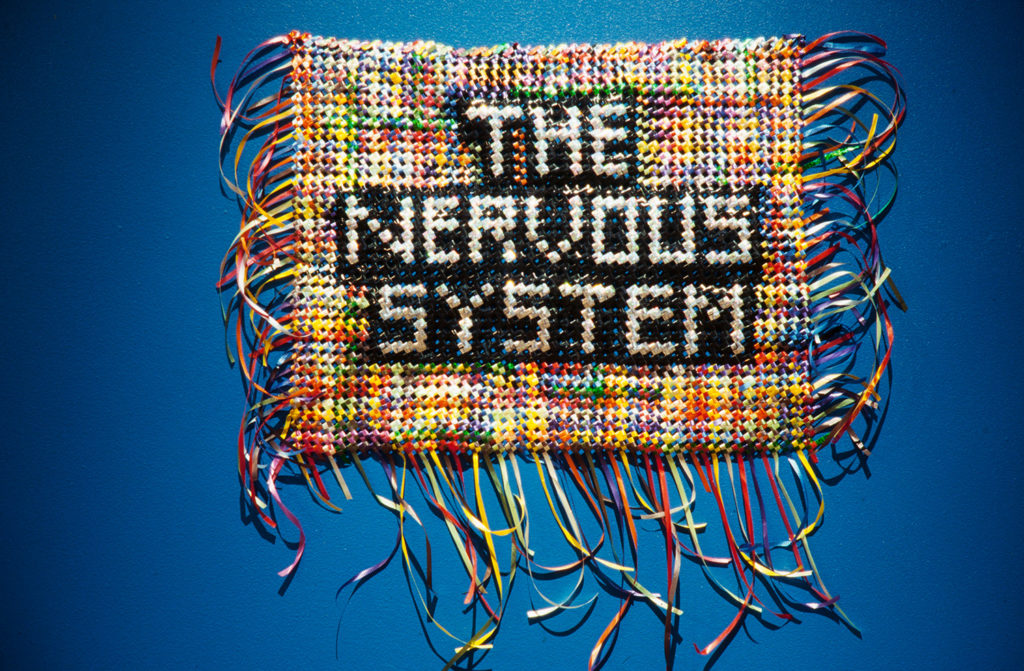ARTISTS Shane Cotton, Luise Fong, Jacqueline Fraser, Denise Kum, John Lyall, Dennis O’Connor, Ani O’Neill, Michael Parekowhai, Michael Shepherd, Yuk King Tan, Sanjay Theodore, Leon van den Eijkel CURATOR Allan Smith PARTNER Govett-Brewster Art Gallery, New Plymouth OTHER VENUE Govett-Brewster Art Gallery, 9 September–23 October 1995 PUBLICATION essays Peter Brunt, Annamarie Jagose, Tony Lee, Leonie Pihama, Allan Smith
The Nervous System is an identity-politics show, offering a multicultural view of New Zealand. The title is a quote from Michael Taussigs 1993 book Mimesis and Alterity. For Curator Allan Smith, ‘The Nervous System is a model for the tangled web of social, political, and physical forces in which we live.’ The show explores cultural, social, and ethnic identity in change and crisis.
Fragments and fragmentation are key. Yuk King Tan's installation Ping is a group of small Chinese fans, arranged on retail display hooks, ready to catch the tourist’s eye. Each bears a black-and-white screen-print of an Asian woman's ear, eye, nose, or mouth. Ping depicts both system and derangement. Smith says, 'The fans reveal a self-image under extreme pressure as continual attempts to look, speak or hear according to conflicting cultural expectations produce distortion, caricature and disorientation.'
Ethnicity is foregrounded. The catalogue lists the heritage of each artist. Luise Fong’s Dragon—a piece of Taranaki driftwood fashioned into a sculpture and painted black—refers to her Chinese Malay heritage. Sanjay Theodore's painting Curious Orange—which combines cracked pepper and garam masala referring to the spice trade, alongside crushed paua shell— intermingles his North Indian and New Zealand upbringing. Denis O'Connor's paintings are inscribed with Gaelic and allude to his Father's immigrant experience. Meanwhile, Denise Kum's installation Cupel features Chinese pharmaceutical cupping glasses in a layer of petrolatum.
In his catalogue essay, Smith begins, 'Increasingly we are experiencing local and global history as a series of shocks.’ Perhaps Leon van den Eijkel's golden mannequin is ready to receive those shocks. This figure demonstrates acupressure points. Van den Eijkel's lightboxes depict the intersection of Eastern and Western medicines, especially acupuncture when used as an anaesthetic. His large ongoing work, Restructure, recalls fellow Dutch artist Piet Mondrian, who sought to bring "equilibrium" to abstraction. But is art a healing agent and can equilibrium be achieved?
The body and its traces are recurring motifs linking the otherwise intentionally disparate artworks and artists. John Lyall's photographs of temporary fun-fur installations set in the bush are examples of psychaesthesia (a psychological disturbance) between the self and the world. His tent is camouflaged in cheap leopard print fabric but sticks out as artificial, a simulation of the real.
Ani O'Neill exhibits ten lei, made from sweets foil wrappers, made for her ten-year-old sister's birthday. In the Gallery, the birthday gifts are disembodied, the sweets sucked. Jaqueline Fraser also uses 'scavenged' materials. Her electrical wire fabrications twist and entwine post-colonial narratives. Her The Deification of Mihi Waka depicts a community, a mountain, and an individual.
Smith tells media, 'The exhibition generates a sense of the volatility that characterises our present fragmented urban condition in which shifting pieces of inherited, borrowed and regenerated cultural material shape the precarious sense of who we are. The Nervous System is a characteristic of our anxious planet and the current volatile state of our social and psychic structures.’
Reviews prove equally volatile. In a brief Listener roundup, Justin Paton describes the show as ‘a grab-bag of artists strike sparks at the interface of the Pākehā, Chinese, Indian and Māori artistic traditions’. He identifies Denise Kum, Shane Cotton, and the ‘ubiquitous’ Luise Fong as ‘current curator's pets’. (Fong recently won the 1994 Visa Gold Award and completed a residency at the Govett-Brewster.)
In her Dominion review, Louise Garret writes, 'They're “all” represented here, from Celtic to Asian, Dutch to Pacific Islander, British to Maori, to somehow prove the multicultural nature of our nation … here there is a tendency for “issues” to dominate: this is exacerbated by the unwieldy and incomprehensible wall plaques which sit next to each work.’ She concludes, 'The way ethnicity is dealt with here is too facile.'
For Anna Sanderson writing in Monica, many of the artists are ‘stock figures’ of the thematic group show. She sees the art as incidental, identifying ‘curation’ as the star of the show. ‘In the harsh light of the gallery there was the feel of official multiculturalism paradoxically colourful but dull.’ However, ‘To turn a failing into a successful complication though, the way in which the pieces sat in ironic separateness, did seem to exude an essentially urban dysfunctionality.’

















































































































